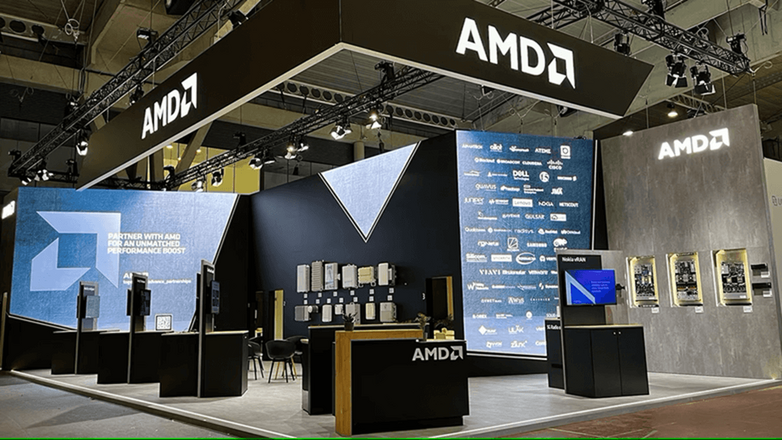
Advanced Micro Devices (AMD) has reported record third-quarter 2025 results, underscoring its rapid ascent in the data center and GPU acceleration markets. Revenue climbed to an all-time high of $9.2 billion, up 36% year-over-year, driven largely by soaring demand for EPYC data center processors and Instinct AI accelerators.
The results signal that AMD’s transformation into a cornerstone supplier for large-scale cloud and AI infrastructure is accelerating.
AMD’s Data Center segment revenue rose 22% year-over-year to $4.3 billion, fueled by robust adoption of fifth-generation EPYC processors and the expanding deployment of the Instinct MI300 and MI350 GPU series, designed for AI training and high-performance computing workloads. CEO Dr. Lisa Su said the company’s “expanding compute franchise and rapidly scaling data center AI business” are setting the stage for sustained growth.
The company’s data center momentum comes as hyperscalers, cloud providers, and enterprise AI developers race to secure GPU capacity amid global shortages and rising compute demand. AMD has positioned itself as a credible rival to NVIDIA in the high-end GPU market by targeting large language model (LLM) training and inference workloads with its Instinct accelerator family, supported by its open-source ROCm software ecosystem.
Recent partnership announcements demonstrate AMD’s growing relevance to the global AI infrastructure supply chain. OpenAI selected AMD as a core preferred partner to deploy 6 gigawatts of AMD GPUs, beginning with a 1-gigawatt rollout of Instinct MI450 accelerators in 2026. Oracle Cloud Infrastructure (OCI) will introduce the first publicly available AI supercluster based on AMD’s new “Helios” rack-scale design, combining Instinct MI450 GPUs with EPYC “Venice” CPUs and Pensando “Vulcano” networking technology. Other hyperscalers, including Vultr, DigitalOcean, and IBM, have also expanded their AMD-based AI and compute offerings in recent months.
Beyond cloud partnerships, AMD’s GPU roadmap continues to gain traction among government and scientific customers. The company recently announced two U.S. Department of Energy supercomputing projects – the Lux AI Supercomputer and the Discovery system – both leveraging next-generation EPYC CPUs and Instinct GPUs for AI and scientific workloads. The Lux system, powered by the Instinct MI355X, will become the first U.S. “AI factory supercomputer.”
AMSD’s Integration of CPUs, GPUs, Networking
This surge in AI infrastructure deals has placed AMD at the center of a data center transformation driven by liquid-cooled GPU racks, energy efficiency, and AI-optimized interconnects. Analysts note that AMD’s integration of its CPUs, GPUs, and networking IP gives it a competitive edge in full-stack performance tuning for enterprise and hyperscale environments.
Financially, AMD’s Q3 non-GAAP gross margin reached 54%, with non-GAAP operating income at $2.2 billion – both well above last year’s levels. Data center sales accounted for nearly half of total revenue, reflecting how crucial the segment has become to AMD’s growth story.
AMD CFO Jean Hu said the company’s disciplined execution and strong AI-related demand enabled record free cash flow, further supporting its long-term investments in high-performance computing.
While the quarter did not include revenue from Instinct MI308 GPU shipments to China, the company’s forward guidance for Q4 anticipates continued growth, projecting revenue around $9.6 billion and a gross margin of 54.5%. That trajectory suggests AMD expects data center and AI sales to remain a key growth engine into 2026.
The company’s progress also mirrors broader structural changes in the data center market. Hyperscalers are increasingly diversifying their silicon suppliers to reduce dependency on a single GPU vendor. AMD’s growing list of partners – from AWS and Oracle to Cisco, IBM, and Cohere – reflects confidence in its ability to deliver high-performance, scalable alternatives to NVIDIA hardware.
At the same time, AMD continues to optimize software and integration layers to simplify AI deployment. The release of ROCm 7 adds new management and orchestration tools, allowing enterprise customers to train and deploy AI models more efficiently across heterogeneous compute environments.
For the colocation, hosting, and enterprise cloud markets, AMD’s expanding GPU and CPU portfolio provides a critical path to delivering AI-ready data center capacity without relying solely on proprietary ecosystems. With energy-efficient design, open software, and interoperability with standard infrastructure, AMD is positioning itself as a practical choice for B2B service providers building the next generation of AI and high-performance computing environments.





